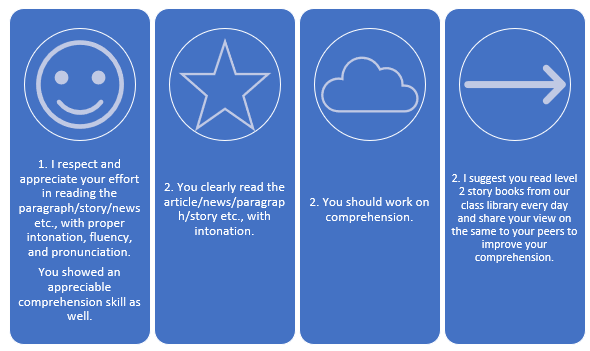This year one of the favourite activities was teaching my students how to create constructive and effective feedback.
It took a month for my second graders and I to come to an agreement with our assessment and feedback strategies. As teachers, most of us are used to quotes such as “you earn a star for …” and other positive statements to encourage our student’s performance. This helped me to formulate a feedback strategy.
We started the year by agreeing to use the three known icons of ‘smiley’, ‘star’ and ‘cloud’. We co-constructed the meaning of each character and used them in the class orally. We defined it as follows:
- Smiley for exceptionally good without errors
- Star for progressive outcome
- Cloud for areas that require scope for improvement.
This way my students and I were happy to welcome feedback positively. In addition, the forward arrow or the right arrow symbol in the feedback indicated how to work on the progress. This helped my students to assign the symbols and the relevant feedback and feedforward with ease.

The usage of characters such as star, cloud, smile and forward arrow or right arrow for feedback and feedforward helps learners to connect easily and show progress.

-
Above is a sample feedback and feedforward that was given to my learners during reading assessment and reading learning experiences.
-
Feedforward can be given to children achieving grade level expectations to drive them to the next level based on their ability or skill focus.
At the end of every task, I encouraged my students to share their oral reflections on their own work. I also shared the feedback in their reflection sheet/task sheet. The teacher’s feedback had given them the opportunity to witness how feedback looks and encouraged them to work on their ‘clouds’. Every six weeks, we focused on the ‘cloud’ points and how we could progress.
Later during the second half of the year, I co-constructed the rubric with my students for the activities that we reflect on. They came up with criteria for assessment such as skill, content, and handwriting based on the activities they engaged in during class. At the end of the year, they were able to create a rubric and assess their peers.
Understanding that student ownership is the key, I ensured my learners checked that their feedback was justifiable. I also guided them by making any necessary amendments for improvement. This way I helped my learners to reflect and provide constructive feedback to their peers.

Ms Sathya Karunakaran holds a master’s degree in biotechnology. Working as a primary year facilitator since 2016 and presently teaching middle school biology at The Pupil International School, India. Her passion lies towards building a strong and sensitive generation of learners and creating awareness about sustainable future through substantiable development goals (SDGs)

No comments yet.